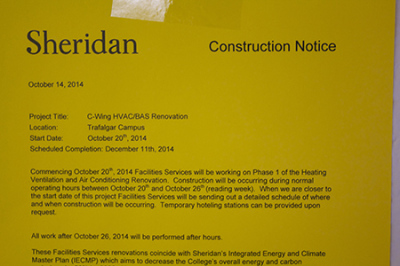
STORY BY FILIPE DOS SANTOS
Trafalgar Campus’ C-Wing came under quarantine during reading week as crews removed asbestos from the existing ventilation system and ceiling tiles.
The project began on Oct. 24 and is scheduled to run until early December.
According to Chad Mansell, facilities project manager at Sheridan’s Oakville campus, the school is not actively looking for asbestos to remove, but if they find it when doing renovations, they remove it according to protocol. Removal crews are required to wear full safety gear and must clearly mark and fully enclose their work sites.
As of Oct. 28, all of the targeted asbestos in C-Wing had been removed.
“It’s typically not a project to identify and go and blitz a large area of asbestos. The project is either a renovation or infrastructure upgrades and while we’re in that area, as we plan the work, we review the asbestos reports,” he said.
“We’re not removing asbestos because it was a risk,” Mansell said, adding that it was being removed as a matter of course.
MORE RELATED TO THIS STORY:
- Breaking ground at Sheridan’s HMC2
- Trafalgar Two up and running… sort of
- Solar panels light up Davis
Sheridan contracted asbestos removal to Caliber Environmental Construction Services Inc. of Richmond Hill, Ontario. A second company, Pinchin Environmental Ltd. was brought in to monitor the air quality during the removal.
Asbestos, used widely in construction until the 1980s, is a naturally occurring material with good insulating properties. It is still mined today despite being classified as carcinogenic and linked to diseases such as mesothelioma and asbestosis.
Although some wings at Sheridan’s Oakville campus were built prior to 1980, school officials remain unsure of how much asbestos there actually is at the school.
“We don’t have a volume or a square foot; we don’t have any measure like that,” said George Georgopoulos, manager of occupational health and safety at Sheridan.
“It’s typically not a project to identify and go and blitz a large area of asbestos. The project is either a renovation or infrastructure upgrades and while we’re in that area, as we plan the work, we review the asbestos reports,” facilities project manager, Chad Mansell.
Though the school is not actively attempting to remove all the asbestos, there is no risk to students, Georgopoulos said.
According to the Ontario Guide to the Regulation Respecting Asbestos in Construction Projects and in Buildings and Repair Operations, a material need only contain 0.5 per cent asbestos to be considered an asbestos-containing material.
Kelly Kwon, an occupational health and safety specialist at Sheridan, said the low margin is why tests were not carried out to determine the percentage of asbestos in the ceiling tiles in C-wing. That would be “redundant and unnecessary.”
“It’s important to just use the term asbestos-containing material,” Georgopoulos said. “It’s not existing in a raw form in stalactite shapes or anything like that.”
Loose asbestos in the tiles and ventilation system is considered ‘friable’ and is the most dangerous kind. According to Georgopoulos, the C-Wing asbestos is not friable.
In June 2011, visible piping all over B-wing at Davis Campus was found to contain asbestos-containing material, according to a Pinchin Environmental report.
“Now we have less asbestos in C-wing and overall in the college,” said Georgopoulos “So it’s a win-win. We’re dealing with asbestos and they’re upgrading the HVAC system,” Georgopoulos said.
“It was a well-planned project that did a lot of things at one time.”
